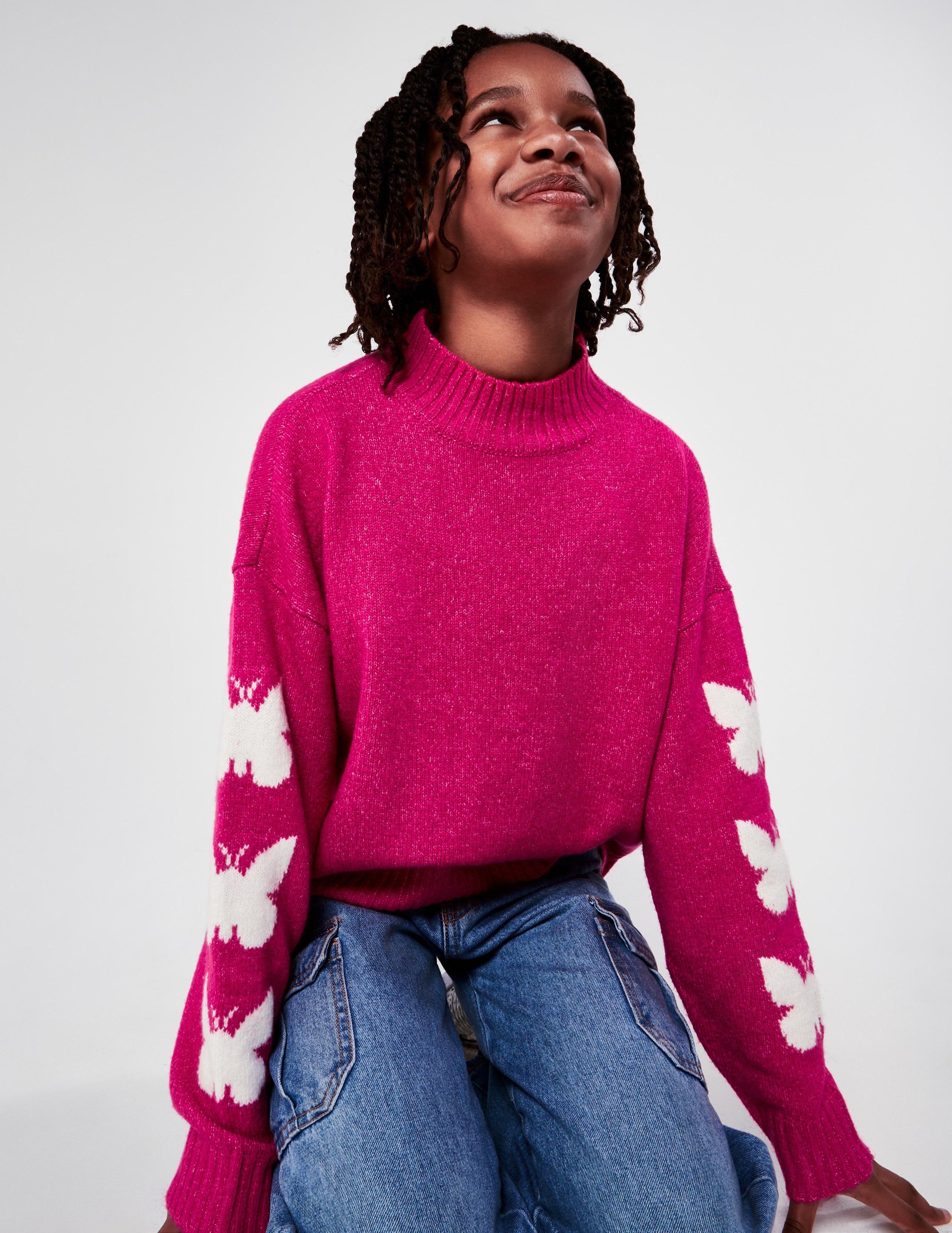
11 minute read
The Pink Paradigm
Once synonymous with traditional gender roles and limitations, the color pink is experiencing a profound rebirth, evolving into a symbol of strength and empowerment for girls and women.
Essay by Oona S. '26 | Photos by Devon Trunk
In past decades, pink has been the predominant color associated with femininity. From the moment a baby girl is born in the hospital, a pink hat is put on her head. In most cases, baby shower gifts and room decor are all pink for girls. Yet this wasn’t always the case, and it should be noted that this change is fairly recent.
Finding a color more politically and socially divisive than pink is difficult. First of all, pink wasn’t always associated with femininity, fragility, or delicacy. In the 19th century, it actually used to represent power, wealth, and status. Pink clothing was incredibly expensive to maintain, meaning that only the wealthiest men (and women) would be seen sporting the elusive clothing. Historic 19th-century portraits depict nobility and high-class families wearing all pink as a status symbol. Little boys were painted in large, extravagant pink dresses, symbolic of their family's power as they could afford to dress their children in the finest colors.
Pink was also viewed as more of a man's color, equating it to the new red because red was aggressive and manly. The Earnshaws Infant’s Department, a trade publication in 1918, wrote that the general rule that should be followed is that blue is for girls and pink is for boys. Their reasoning was that “pink, being a more decided and stronger color, is more suitable for the boy, while blue, which is more delicate and dainty, is prettier for the girl.”
But because the meanings we assign to inanimate objects and colors are socially constructed, inevitably, as humans change, so do the associated connotations. In the early 20th century, pink clothing became more and more marketed toward women, and American society began seeing men wearing pink as flamboyant and flashy; inappropriate and too feminine. And here is where the cultural shift begins.
When I began exploring the beginnings of the “girl color,” there was only one consistency: nothing was consistent. Across many sources, videos, and articles, we cannot collectively decide there was just one moment when pink changed. Some people have pointed to Mamie Eisenhower’s pink ball gown from inauguration day; others point to World War II and its impact on women in the workforce. My research pointed me to the 1950’s. At this pivotal time in history, men returned from World War II and resumed the jobs women had taken over in their absence. Although women had been capable of carrying out jobs and functions in the workforce throughout the war, it was suddenly deemed that the jobs they had been incredibly successful at were only fit for men, and the societal expectation was for women to resume their place as homemakers. America was returning to the status quo and telling American women that they belonged in the home. This shift back to “traditional gender roles” was perpetuated through gendered marketing.




Advertisements for cleaning products, washing machines, and cooking supplies all became pink.
Fast forward to today, this isn’t the only example of gendered marketing or stereotypes. Today, most toys marketed to girls are pink. Princess dresses, mini kitchen sets, and dollhouses are usually found in pink colors.
In her 2011 book "Cinderella Ate My Daughter", author Peggy Orenstein discusses the “princess” market. The industry that is standing upon pillars of pink and sparkle is marketed towards young girls. In the book, she explains that nearly every toy for girls was pink or sparkly. She asks the sales representative if all the pink is truly “necessary,” and he responds, “Only if you want to make money.” The hidden agenda of these businesses is to make money through the color pink being marketed to girls.
So if pink is associated with young girls, then what could be more frightening to a 200 pound college football player than being indirectly called a little girl?
In 1979, the University of Iowa painted the guest football locker room in Kinnick Stadium pink. In a FOX Sports video, they describe that the purpose of the locker is to make “...you feel weak and pathetic. This isn’t love; it's disrespect. And that’s the point. They’re in your head, and you're not even in the tunnel yet.” The video insinuated pink as an attack on masculinity, relaying the point that women are less than and weaker than men. Men's inherent aversion to pink is fuel to the fire that is toxic masculinity. It reiterates the idea that men should always fear being weak and that the color pink is also weak.
However, we paradoxically live in a world where pink is seen as feminine, fragile, and delicate but also powerful, innovative, optimistic, and progressive.
My first childhood bedroom is proudly described as “gender neutral” by both my parents. I had green curtains, a green-toned rug, and a brown chair. There wasn’t anything pink to symbolize the room as the nursery of their first-born daughter. But when we lived in Toronto, we painted my room pink in 2016. It didn’t occur to me until now that this was an intentional choice by my mother. We painted my room pink in the midst of a presidential election, an election in which a major party was represented by a woman. How empowering.
I was 10 when I attended the infamous women’s marches in Los Angeles in 2016. I can tell how little I was because my gapped-tooth smile goes from ear to ear in every picture. I was mesmerized by the sea of pink “pussyhats.”
This protest was the first time I felt I was a part of something bigger than myself. It was the first time I knew I was making a difference.
Millions of women participating in these marches took to the streets outraged and wore pink. How could a man be our president when he openly talks about grabbing women “by the pussy”? It was a phrase by a man who bragged about taking away the power that women held. But in those marches, we rose. Together, we reclaimed the word pussy and the color pink. Women across the country took back the power and used their outrage to fuel a movement. A movement which continues to galvanize us to fight for the disassembly of the patriarchy and give birth to a new era of gender equality. Personally, “revolutionary” doesn’t even begin to describe how influential the women’s marches were for that young 10-year-old girl.
The momentum of the pink movement continued throughout the years that followed. In their Fall/Winter 2022-2023 collection, Italian fashion house Valentino sent down the runway an entire line in a new signature Pierpaolo Pink (PP). The Pantone Color Institute, recognized globally as the leading source of color expertise, collaborated with the Maison-developed Pink PP. Though pink in fashion is clearly not a new phenomenon, what sets Pierpaolo Pink apart is that it symbolizes something new. In an article with AnOther Magazine, Pierpaolo Piccioli, Valentino’s Creative Director, says, “Pink is maybe the color that has the most progressive thoughts about it—so you understand that it’s all about perceptions. This collection was an invitation not to think with superficiality but to have an open mind and see everything with fresh eyes.”
Today, we see men wearing more pink than at any time in the last 70 years. The pink movement is not exclusive to women reclaiming it for themselves. In the last 70 years and even in the last five years, our society has collectively grown more conscious of gender stereotypes and biases. We are seeing more and more open conversations about the harm caused by rigidly associating genders with jobs, colors, etc. This open conversation has brought out a new wave of people of all gender identities wearing pink fearlessly.
Inter Miami CF was consistently a losing team for two years before their rebranding and acquisition of their star player, Lionel Messi. According to a Sports Illustrated article about Inter Miami’s renaissance, the pink jersey is them making a statement. “After two years, pink represents Inter’s chance to realize its potential—it reflects a key moment of transition and the club’s willingness to address prior shortcomings and make bold moves.”
Compared to the attitudes towards pink at Iowa University, Inter Miami is redefining how pink is portrayed in sports. No longer will it symbolize weakness or fragility, but rather optimism and potential. Our society is growing into the idea that pink is powerful and more change is coming.
In the spirit of new beginnings, pink gains the symbolic connotation of optimism for a new future.
One of the most inspiring things about the pink movement is that it is international, diverse, and inclusive. Take the Gulabi Gang. The Gulabi Gang (Gulabi is Hindu for pink) is an anti-domestic violence group founded in India that has famously claimed a bright Fuschia as its color. They protect women from abuse and violence in the rural and poorer areas throughout India and actively fight against child marriages. Their choice of color, like Inter Miami FC, was symbolic and strategic. In an article for Color Studies, photographer Bob Hambly explains that pink “is an emotionally charged color that has stirred women and men for centuries... All colors abound with history, meaning, and symbology. Pink has blossomed into a hue that now represents strong-willed individuals and groups who choose to be seen and heard.”
Symbolism and perceptions of color are an important part of many cultures and societies around the world. If you wanted to paint your baby girl’s room pink in 2022, you might have had some trouble due to another famous and stereotypical female figure, Barbie. On the "Barbie" set (2023), they used an entire global supply of Rosco’s paint for the set of the movie.
“Barbie”—both the cause of the revolution and something so revolutionary. The movie itself is packed with brilliance and thoughtful nuances about the world around us. But one line that I haven’t been able to get out of my head is when the fictional CEO of Mattel, Will Ferrell’s character, says, "We sell dreams, imagination, and sparkle. And when you think of sparkle, what do you think of next? Female agency."
Growing up, I wasn’t allowed to have a Barbie. My mom said, “I didn’t want you feeling bad about yourself, but now, I’m forcing* you to watch 'Barbie' many times because it is changing our world.” I noted an asterisk around “forcing” because I would watch “Barbie” 100 times voluntarily.
Greta Gerwig’s 2023 “Barbie” forces us to look at the way our society is set up. It’s uncomfortable at times. It’s hilarious during others. Do pink, Barbie, and sparkles really make you think of female agency? Probably not, but I believe that the connotations associated with pink are changing.
America Ferrera’s character says, “I want to be a part of the people who make meaning,” and that is what each woman is doing today. As we reclaim the color pink, in all of its complexities and all of its history, we forge a new meaning for the color. Together, we are all making a difference.
Yet, even with all of this progress, we still have so much further to go in the journey of female empowerment. Despite bringing home over a billion dollars at the box office, being the highest-grossing movie directed only by a woman and the most successful release in Warner Bros. history, and earning critical acclaim, neither Greta Gerwig nor Margot Robbie were nominated for Oscars for Best Director or Best Female Actor, respectively. Ryan Gosling, who portrays “Ken” in the film, was nominated for Best Supporting Actor, and fans on X (formerly Twitter) have been quick to point out that without Barbie, there would be no Ken—similar to what the movie conveys. Is it possible that the pink, sparkles, and dancing took away from the message in the film? I don’t think so; I believe it only enhanced the themes.
Taylor Swift truly says it best in her Miss Americana documentary, “I wanna love glitter and also stand up for the double standards that exist in our society. I wanna wear pink and tell you how I feel about politics. I don’t think those things have to cancel each other out.”
They don’t. Not anymore. Because we are in an era where pink is shedding the labels it used to have and gaining new ones, everyone is impacting the year of pink, and everyone is a part of the change.




